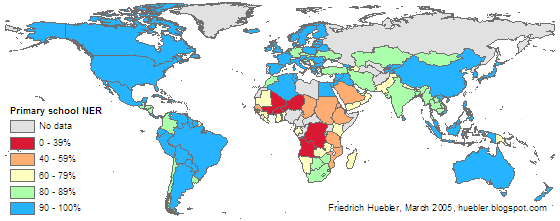The map below was created with data from the Global Education Digest 2004, published by the UNESCO Institute for Statistics. It shows the primary school net enrollment ratios in 174 countries for which data was available. The net enrollment ratio (NER) is the share of children of primary school age that are currently enrolled in school. When the NER is at 100%, all children are attending primary school at the proper age.
Primary school net enrollment ratio, 2001/2002

Data source: UNESCO Institute for Statistics (UIS). 2004. Global Education Digest 2004. Montreal: UIS.
The most recent data in the Global Education Digest covers the school year 2001/2002. In countries without data for 2001/02, I used enrollment ratios from previous years, as far back as 1998/99. The map shows that many countries in the world are close to reaching the goal of primary education for all children. Many other countries, primarily in Africa, have to make significant progress during the next ten years to reach this goal. In 17 countries - all in Africa and the Middle East - not more than six out of ten children of primary school age were enrolled in primary school: Angola (30%), Djibouti (34%), Niger (34%), Democratic Republic of the Congo (35%), Burkina Faso (35%), Mali (38%), Eritrea (43%), Guinea-Bissau (45%), Sudan (46%), Ethiopia (46%), Burundi (53%), Tanzania (54%), Comoros (55%), Senegal (58%), Chad (58%), Saudi Arabia (59%), and Mozambique (60%).
Friedrich Huebler, 15 March 2005, Creative Commons License
No comments:
Post a Comment